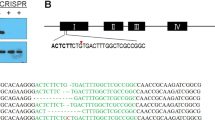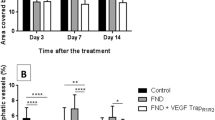Abstract
The scarring response is an important factor in many diseases throughout the body. In addition, it is a major problem in influencing results of surgery. In the eye, for example, post-operative scarring can determine the outcome of surgery. This is particularly the case in the blinding disease glaucoma, where several anti-scarring regimens are currently used to improve glaucoma surgery results, but are of limited use clinically because of severe complications. We have recently identified transforming growth factor-β (TGF-β) as a target for post-operative anti-scarring therapy in glaucoma, and now report the first study of novel second-generation antisense phosphorothioate oligonucleotides against TGF-β in vivo. Single applications of a TGF-β OGN at the time of surgery in two different animal models closely related to the surgical procedure performed in glaucoma patients, significantly reduced post-operative scarring (P<0.05) and improved surgical outcome. Our findings suggest that TGF-β antisense oligonucleotides have potential as a new therapy for reducing post-surgical scarring. Its long-lasting effects after only a single administration at the time of surgery make it particularly attractive clinically. Furthermore, although we have shown this agent to be useful in the eye, it could have widespread applications anywhere in the body where the wound-healing response requires modulation.
This is a preview of subscription content, access via your institution
Access options
Subscribe to this journal
Receive 12 print issues and online access
$259.00 per year
only $21.58 per issue
Buy this article
- Purchase on Springer Link
- Instant access to full article PDF
Prices may be subject to local taxes which are calculated during checkout






Similar content being viewed by others
References
Thylefors B, Negrel A . The global impact of glaucoma. Bulletin World Health Org 1994; 72: 323–326.
Foster A, Johnson GJ . Magnitude and causes of blindness in the developing world. Int Ophthalmol 1990; 14: 135–140.
Quigley HA . Number of people with glaucoma worldwide. Br J Ophthalmol 1996; 80: 389–393.
Sommer A . Glaucoma: facts and figures (Doyne lecture). Eye 1996; 10: 295–301.
Jay JL . Rational choice of therapy in primary open angle glaucoma. Eye 1992; 6: 243–247.
Migdal C, Gregory W, Hitchings RA . Long-term functional outcome after early surgery compared with laser and medicine in open-angle glaucoma. Ophthalmology 1994; 101: 1651–1656.
The AGIS Investigators. The advanced glaucoma intervention study (AGIS): 7. The relationship between control of intraocular pressure and visual field deterioration. Am J Ophthalmol 2000; 130: 490–491.
Addicks EM, Quigley HA, Green WR, Robin AL . Histologic characteristics of filtering blebs in glaucomatous eyes. Arch Ophthalmol 1983; 101: 795–798.
Hitchings RA, Grierson I . Clinico pathological correlation in eyes with failed fistulizing surgery. Trans Ophthalmol Soc UK 1983; 103: 84–88.
Stamper RL, McMenemy MG, Lieberman MF . Hypotonous maculopathy after trabeculectomy with subconjunctival 5-fluorouracil. Am J Ophthalmol 1992; 114: 544–553.
Parrish R, Minckler D . Late endophthalmitis – filtering surgery time bomb? Ophthalmology 1996; 103: 1167–1168.
Jampel HD, Pasquale LR, Dibernardo C . Hypotony maculopathy following trabeculectomy with mitomycin C. Arch Ophthalmol 1992; 110: 1049–1150.
Ashcroft GS et al. Estrogen accelerates cutaneous wound healing associated with an increase in TGF-beta1 levels. Nat Med 1997; 3: 1209–1215.
Shah M, Foreman DM, Ferguson MW . Neutralisation of TGF-beta 1 and TGF-beta 2 or exogenous addition of TGF-beta 3 to cutaneous rat wounds reduces scarring. J Cell Sci 1995; 108: 985–1002.
Levine JH, Moses HL, Gold LI, Nanney LB . Spatial and temporal patterns of immunoreactive transforming growth factor-beta-1, -beta-2 and -beta-3 during excisional wound repair. Am J Pathol 1993; 143: 368–380.
Merwin JR et al. Vascular cell responses to TGF-β3 mimic those of TGF-β1 in vitro. Growth Factors 1991; 5: 149–158.
Lutty GA et al. Heterogeneity in localization of isoforms of TGF-beta in human retina, vitreous and choroid. Invest Ophthalmol Vis Sci 1993; 34: 477–487.
Pasquale LR et al. Immunolocalisation of TGF-beta1, TGF-beta2 and TGF-beta3 in the anterior segment of the human eye. Invest Ophthalmol Vis Sci 1993; 34: 23–30.
Imanishi J et al. Growth factors: importance in wound healing and maintenance of transparency of the cornea. Prog Retin Eye Res 2000; 19: 113–129.
Connor TB et al. Correlation of fibrosis and transforming growth factor-beta type 2 levels in the eye. J Clin Invest 1989; 83: 1661–1666.
Kon CH, Occleston NL, Aylward GW, Khaw PT . Expression of vitreous cytokines in proliferative vitreoretinopathy: a prospective study. Invest Ophthalmol Vis Sci 1999; 40: 705–712.
Carrington L, McLeod D, Boulton M . IL-10 and antibodies to TGF-beta2 and PDGF inhibit RPE-mediated retinal contraction. Invest Ophthalmol Vis Sci 2000; 41: 1210–1216.
Lee EH et al. Overexpression of the transforming growth factor-beta-inducible gene betaig-h3 in anterior polar cataracts. Invest Ophthalmol Vis Sci 2000; 41: 1840–1805.
Nishi O, Nishi K, Wada K, Ohmoto Y . Expression of transforming growth factor (TGF)-alpha, TGF-beta(2) and interleukin 8 messenger RNA in postsurgical and cultured lens epithelial cells obtained from patients with senile cataracts. Graefes Arch Clin Exp Ophthalmol 1999; 237: 806–811.
Saika S et al. Immunolocalization of TGF-beta1, -beta2, and -beta3, and TGF-beta receptors in human lens capsules with lens implants. Graefes Arch Clin Exp Ophthalmol 2000; 238: 283–293.
Cordeiro MF, Gay JA, Khaw PT . Human anti-TGF-β2 monoclonal antibody: a new anti-scarring agent for glaucoma filtration surgery. Invest Ophthalmol Vis Sci 1999; 40: 2225–2234.
Cordeiro MF et al. TGF-β1, -β2 & -β3 in vivo: effects on normal and Mitomycin-C modulated conjunctival scarring. Invest Ophthalmol Vis Sci 1999; 40: 1975–1982.
Cordeiro MF, Bhattacharya SS, Schultz GS, Khaw PT . TGF-β1, -β2 & -β3 in vitro: biphasic effects on Tenon's fibroblast contraction, proliferation & migration. Invest Ophthalmol Vis Sci 2000; 41: 756–763.
Siriwardena D et al. Human anti-transforming growth factor beta-2 monoclonal antibody – a new modulator of wound healing in trabeculectomy: a randomised placebo controlled clinical study. Ophthalmology 2002; 109: 427–431.
Tamm I, Dorken B, Hartmann G . Antisense therapy in oncology: new hope for an old idea? Lancet 2001; 358: 489–497.
Orr RM . Technology evaluation: fomivirsen, Isis Pharmaceuticals Inc/CIBA vision. Curr Opin Mol Ther 2001; 3: 288–294.
Lang KA, Peppercorn MA . Promising new agents for the treatment of inflammatory bowel disorders. Drugs R D 1999; 1: 237–244.
Yacyshyn BR et al. A placebo-controlled trial of ICAM-1 antisense oligonucleotide in the treatment of Crohn's disease. Gastroenterology 1998; 114: 1133–1142.
Crooke ST . Basic principles of antisense technology. In: Crooke ST (ed). Antisense Drug Technology: Principles, Strategies and Applications. Marcel Dekker: New York, 2001, pp 1–28.
Stephenson ML, Zamecnik PC . Inhibition of Rous sarcoma viral RNA translation by a specific oligodeoxyribonucleotide. Proc Natl Acad Sci USA 1978; 75: 285–288.
Dean NM, Butler M, Monia BP, Manoharan M . Pharmacology of 2′-O-(2-methoxy) ethyl-modified antisense oligonucleotides. In: Crooke ST (ed). Antisense Drug Technology: Principles, Strategies and Applications. Marcel Dekker: New York, 2001, pp 319–338.
Dean NM, Griffey RH . Identification and charecterization of second-generation antisense oligonucleotides. Antisense Nucleic Acid Drug Develop 1997; 7: 229–233.
Reichel MB et al. New model of conjunctival scarring in the mouse eye. Br J Ophthalmol 1998; 82: 1072–1077.
Cordeiro MF et al. Role of TGF-β in conjunctival scarring. Clin Sci 2002 (in press).
Cordeiro MF et al. The effect of varying mitomycin-c treatment area in glaucoma filtration surgery in the rabbit. Invest Ophthalmol Vis Sci 1997; 38: 1639–1646.
Reichel ML et al. A new model of conjunctival scarring in the mouse eye. Invest Ophthalm Vis Sci 1996; 37: 91.
Flanders KC, Holder MG, Winokur TS . Autoinduction of mRNA and protein expression for transforming growth factor-beta S in cultured cardiac cells. J Mol Cell Cardiol 1995; 27: 805–812.
Cordeiro MF . Beyond Mitomycin – TGF-β and wound healing. Prog Ret Eye Res 2002; 21: 75–89.
Jampel HD, Roche N, Stark WJ, Roberts AB . Transforming growth factor-beta in human aqueous humor. Curr Eye Res 1990; 9: 963–969.
Tripathi RC, Li J, Chan WF, Tripathi BJ . Aqueous humor in glaucomatous eyes contains an increased level of TGF-beta 2. Exp Eye Res 1994; 59: 723–727.
Picht G, Welge-Luessen U, Grehn F, Lutjen-Drecoll E . Transforming growth factor beta 2 levels in the aqueous humor in different types of glaucoma and the relation to filtering bleb development. Graefes Arch Clin Exp Ophthalmol 2001; 239: 199–207.
Knisely TL, Bleicher PA, Vibbard CA, Granstein RD . Production of latent transforming growth factor-beta and other inhibitory factors by cultured murine iris and ciliary body cells. Curr Eye Res 1991; 10: 761–771.
Tripathi RC, Chan WF, Li J, Tripathi BJ . Trabecular cells express the TGF-beta 2 gene and secrete the cytokine. Exp Eye Res 1994; 58: 523–538.
Massague J, Chen YG . Controlling TGF-beta signaling. Genes Dev 2000; 14: 627–644.
Lee SB et al. Suppression of TGF-beta signaling in both normal conjunctival fibroblasts and pterygial body fibroblasts by amniotic membrane. Curr Eye Res 2000; 20: 325–334.
Obata H, Kaburaki T, Kato M, Yamashita H . Expression of TGF-beta type I and type II receptors in rat eyes. Curr Eye Res 1996; 15: 335–340.
Wrana JL et al. Mechanism of activation of the TGF-beta receptor. Nature 1994; 370: 341–347.
Nakao A et al. TGF-β receptor-mediated signalling through Smad2, Smad3 and Smad4. EMBO J 1997; 16: 5353–5362.
Piek E, Heldin CH, Ten Dijke P . Specificity, diversity, and regulation in TGF-β superfamily signaling. FASEB J 1999; 13: 2105–2124.
Rotzer D et al. Type III TGF-beta receptor-independent signalling of TGF-beta2 via TbetaRII-B, an alternatively spliced TGF-beta type II receptor. EMBO J 2001; 20: 480–490.
The Fluorouracil Filtering Surgery Study Group. Fluorouracil Filtering Surgery Study one-year follow-up. Am J Ophthalmol 1989; 108: 625–635.
Kitazawa Y, Kawase K, Matsushita H, Minobe M . Trabeculectomy with mitomycin: a comparative study with fluorouracil. Arch Ophthalmol 1991; 109: 1693–1698.
Katz GJ et al. Mitomycin C versus 5-fluorouracil in high-risk glaucoma filtering surgery. Extended follow-up. Ophthalmology 1995; 102: 1263–1269.
Lamping KA, Belkin JK . F5-Fluorouracil and mitomycin C in pseudophakic patients. Ophthalmology 1995; 102: 70–75.
Belyea DA et al. Late onset of sequential multifocal bleb leaks after glaucoma filtration surgery with 5-fluorauracil and mitomycin-C. Am J Ophthalmol 1997; 124: 40–45.
Greenfield DS, Liebmann JM, Jee J, Ritch R . Late-onset bleb leaks after glaucoma filtering surgery. Arch Ophthalmol 1998; 116: 443–447.
Kupin TH et al. Adjunctive mitomycin C in primary trabeculectomy in phakic eyes. Am J Ophthalmol 1995; 119: 30–39.
Crowston JG et al. Antimetabolites-induced apoptosis in Tenon's capsule fibroblasts. Invest Ophthalmol Vis Sci 1998; 39: 449–454.
Author information
Authors and Affiliations
Rights and permissions
About this article
Cite this article
Cordeiro, M., Mead, A., Ali, R. et al. Novel antisense oligonucleotides targeting TGF-β inhibit in vivo scarring and improve surgical outcome. Gene Ther 10, 59–71 (2003). https://doi.org/10.1038/sj.gt.3301865
Received:
Accepted:
Published:
Issue Date:
DOI: https://doi.org/10.1038/sj.gt.3301865
Keywords
This article is cited by
-
Promising Therapeutic Treatments for Cardiac Fibrosis: Herbal Plants and Their Extracts
Cardiology and Therapy (2023)
-
Animal models of scarring control
Eye (2020)
-
Comparison of the Levels of Transforming Growth Factor-β1 in Tear Fluid in Patients with High Myopia after Transepithelial Photorefractive Keratectomy and Laser Subepithelial Keratomileusis (LASEK)
Bulletin of Experimental Biology and Medicine (2020)
-
Glaucoma - Next Generation Therapeutics: Impossible to Possible
Pharmaceutical Research (2019)
-
Local Delivery of CTGF siRNA with Poly(sorbitol-co-PEI) Reduces Scar Contraction in Cutaneous Wound Healing
Tissue Engineering and Regenerative Medicine (2017)



